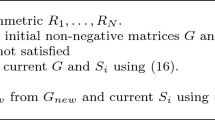Abstract
The research presented here is an improved row-by-row (RBR) algorithm for the solution of boolean quadratic programming (BQP) problems. While a faster and implementable RBR method has been widely used for semidefinite programming (SDP) relaxed BQPs, it can be challenged by SDP relaxations because of the fact that it produce a tighter lower bounds than RBR on BQPs. On the other hand, solving SDP by interior point method (IPM) is computationally expensive for large scale problems. Departing from IPM, our methods provides better lower bound than the RBR algorithm by Wai et al. (IEEE international conference on acoustics, speech and signal processing ICASSP, 2011) and competitive with SDP solved by IPM. The method includes the SDP cut relaxation on the SDP and is solved by a modified RBR method. The algorithm has been tested on MATLAB platform and applied to several BQPs from BQPLIB (a library by the authors). Numerical experiments show that the proposed method outperform the previous RBR method proposed by several authors and the solution of BQP by IPM as well.
Similar content being viewed by others
References
Boyd, S., & Vandenberghe, L. (2004). Convex optimization. Cambridge: Cambridge University Press.
Burer, S., & Monteiro, R. D. C. (2003). A nonlinear programming algorithm for solving semidefinite programs via low-rank factorization. Mathematical Programming, 95, 329–357.
Cour, T., & Bo, J. (2007). Solving Markov random fields with spectral relaxation. In Proceedings of the international conference on artificial intelligence and statistics.
Goldfarb, D., Ma, S., & Wen, Z. (2009). Solving low-rank matrix completion problems efficiently. In IEEE conference on communication and control.
Grant, M., & Boyd, S. (2014). CVX: Matlab software for disciplined convex programming, version 2.1. http://cvxr.com/cvx.
Grant, M., & Boyd, S. (2008). Graph implementations for nonsmooth convex programs. In V. Blondel, S. Boyd, & H. Kimura (Eds.), Recent advances in learning and control, Lecture notes in control and information sciences (pp. 95–110). New York: Springer.
Grippo, L., & Sciandrone, M. (2000). On the convergence of the block nonlinear Gauss–Seidel method under convex constraints. Operations Research Letters, 26, 127–136.
Guattery, S., & Miller, G. (1998). On the quality of spectral separators. SIAM Journal on Matrix Analysis and Applications, 19, 701–719.
Heiler, M., Keuchel, J., & Schnörr, C. (2005). Semidefinite clustering for image segmentation with a-priori knowledge. In Pattern recognition (27th DAGM Symposium) (Vol. 3663 pp. 309–317). Springer.
Joulin, A., Bach, F., & Ponce, J. (2010). Discriminative clustering for image cosegmentation. In Proceedings of the IEEE conference on computer vision.
Kannan, R., Vempala, S., & Vetta, A. (2004). On clusterings: Good, bad and spectral. Journal of the ACM, 51, 497–515.
Keuchel, J., Schnörr, C., Schellewald, C., & Cremers, D. (2003). Binary partitioning, perceptual grouping and restoration with semidefinite programming. IEEE Transaction on Pattern Analysis and Machine Intelligence, 25, 1364–1379.
Kochenberger, G. A., Glover, F., Alidaee, B., & Rego, C. (2005). An unconstrained quadratic binary programming approach to the vertex coloring problem. Annals of Operations Research, 139(1), 229–241.
Lang, K. J. (2005). Fixing two weaknesses of the spectral method. In: Proceedings of advanced neural information processing systems (pp. 715–722).
Lauer, F., & Schnörr, C. (2009). Spectral clustering of linear subspaces for motion segmentation. In Proceedings of the international conference on computer vision.
Malick, J. (2007). The spherical constraint in boolean quadratic programs. Journal of Global Optimization, 39, 609–622.
Nayak, R. K., & Mohanty, N. K. (2017). Bqplib: A library for BQP. https://sites.google.com/a/iiit-bh.ac.in/r-k-nayak/bqp-dataset.
Nayak, R. K., & Biswal, M. P. (2018). A low complexity semidefinite relaxation for large-scale mimo detection. Journal of Combinatorial Optimization, 35(2), 473–492.
Olsson, C., Eriksson, A., & Kahl, F. (2007). Solving large scale binary quadratic problems: Spectral methods vs. semidefinite programming. In Proc. IEEE Conf. Comput. Vis. and Pattern Recogn (pp. 1–8).
Pardalos, P. M. R. (1990). Parallel branch and bound algorithms for quadratic zero-one programs on the hypercube architecture. Annals of Operations Research, 22(1), 271–292.
Powell, M. J. D. (1973). On search directions for minimization algorithms. Mathematical Programming, 4, 193–201.
Schellewald, C., & Schnorr, C. (2005). Probabilistic subgraph matching based on convex relaxation. In Proceedings of the international conference on energy minimization methods in computer visible and pattern recoginition (pp. 171–186).
Shi, J., & Malik, J. (2000). Normalized cuts and image segmentation. IEEE Transactions on Pattern Analysis and Machine Intelligence, 22, 888–905.
Srebro, N. (2004). Learning with matrix factorizations. Ph.D. thesis, Massachusetts Institute of Technology.
Sturm, J. F. (1999). Using SeDuMi 1.02, a MATLAB toolbox for optimization over symmetric cones. Optimizations Methods and Software, 11, 625–653.
Toh, K. C., Todd, M. J., & Tutuncu, R. H. (1999). Sdpt3—A Matlab software package for semidefinite programming (pp. 545–581).
Tutuncu, R. H., Toh, K. C., & Todd, M. J. (2003). Solving semidefinite-quadratic-linear programs using SDPT3. Mathematical Programming Series B, 95, 189–217.
Wai, H. T., Ma, W. K., & So, M. C. A. (2011). Cheap semidefinite relaxation MIMO detection using row-by-row block coordinate descent. In IEEE international conference on acoustics, speech and signal processing ICASSP (pp. 3256–3259).
Wang, P., Shen, C., & Hengel, A. V. D. (2013). A fast semidefinite approach to solving binary quadratic problems. In Proceedings of the IEEE conference on computer vision and pattern recognition.
Wen, Z., Goldfarb, D., Ma, S., & Scheinberg, K. (2009). Row by Row methods for semidefinite programming. Technical report, Department of IEOR, Columbia University.
Wen, Z., & Yin, W. (2013). A feasible method for optimization with orthogonality constraints. Mathematical Programming, 142, 397–434.
Yu, S. X., & Shi, J. (2004). Segmentation given partial grouping constraints. IEEE Transactions on Pattern Analysis and Machine Intelligence, 26, 173–183.
Zhang, F. (2005). The Schur complement and its applications. New York: Springer.
Author information
Authors and Affiliations
Corresponding author
Rights and permissions
About this article
Cite this article
Nayak, R.K., Mohanty, N.K. Improved row-by-row method for binary quadratic optimization problems. Ann Oper Res 275, 587–605 (2019). https://doi.org/10.1007/s10479-018-2978-9
Published:
Issue Date:
DOI: https://doi.org/10.1007/s10479-018-2978-9




